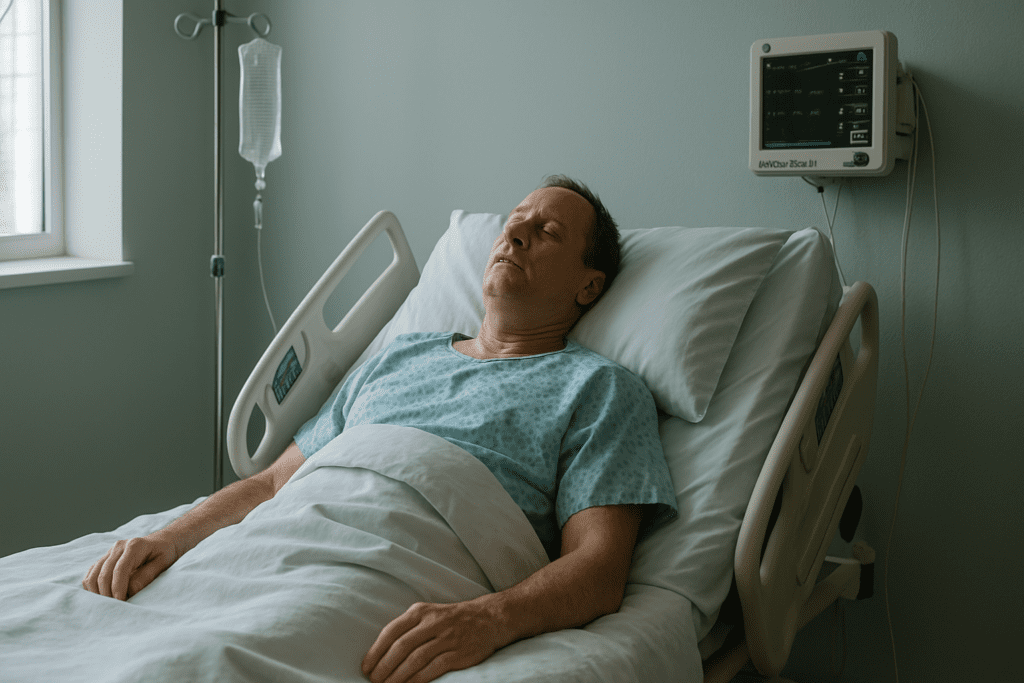Diabetic coma is a life-threatening complication that demands immediate medical attention. It is not a condition in itself, but rather a term used to describe a state of unconsciousness that can result from severe imbalances in blood glucose levels. These can arise due to either dangerously high or dangerously low blood sugar. Despite advancements in diabetes management, diabetic coma remains a serious concern, particularly for those with uncontrolled diabetes or those who are unaware of early warning signs. Understanding what causes a diabetic coma, how to recognize its symptoms, and when emergency treatment is essential can mean the difference between life and death. This article explores the science, symptoms, risk factors, and clinical response protocols behind diabetic coma and related conditions like diabetic shock and insulin shock.
You may also like: How Diabetes Affects the Brain: Understanding Brain Fog, Memory Loss, and Mental Confusion from High Blood Sugar
A Closer Look at Diabetic Coma and Its Root Causes
Diabetic coma can occur as a result of both hyperglycemia and hypoglycemia, highlighting the importance of balanced glucose management in diabetic care. On one end of the spectrum, a sugar coma can result from exceedingly high blood sugar levels, often exceeding 600 mg/dL. This may happen during a condition known as hyperosmolar hyperglycemic state (HHS), which is more common in people with type 2 diabetes. On the other end lies hypoglycemic coma, typically triggered when blood glucose levels fall below 40 mg/dL, leading to severe neurological impairment. This condition is often associated with insulin shock and is particularly common among insulin-dependent individuals.
What causes a diabetic coma is multifaceted. Poorly managed diabetes, skipped insulin doses, excessive alcohol consumption without food, infections, trauma, and even certain medications can all precipitate a diabetic episode. In patients experiencing stress from other medical conditions or surgery, blood sugar levels may swing wildly, increasing the risk of entering a diabetic coma. These mechanisms reflect why shock patients often have hypoglycemia—bodily stress can deplete glucose rapidly, especially when insulin levels are not properly regulated.
The interplay between blood glucose and insulin is central to understanding diabetic coma. In insulin shock, for instance, insulin administration without sufficient carbohydrate intake can lead to a rapid decline in blood sugar. Conversely, missing insulin or failing to treat hyperglycemia in its early stages can escalate into a full-blown diabetic attack. Therefore, consistent monitoring and proactive treatment are essential to avoid these extremes.

Recognizing the Warning Signs of Diabetic Coma
Early detection of diabetic coma symptoms can be life-saving. Symptoms vary depending on whether the underlying cause is high or low blood sugar, but certain warning signs are common to both. These include extreme fatigue, confusion, disorientation, and difficulty speaking or concentrating. Individuals may experience blurred vision, seizures, or even hallucinations in the lead-up to a diabetic coma.
For hyperglycemia-induced coma, signs include frequent urination, excessive thirst, dry mouth, flushed skin, and a rapid heartbeat. As glucose levels soar, dehydration becomes severe, and the brain’s function deteriorates. People may become lethargic and eventually unresponsive. If the condition progresses unchecked, it can reach diabetic coma levels that compromise brain function permanently.
Hypoglycemia presents with a very different but equally dangerous set of symptoms. These include sweating, shakiness, dizziness, anxiety, hunger, and a pounding heartbeat. If these signs are ignored, the individual may experience insulin shock symptoms such as slurred speech, muscle twitching, or convulsions. In extreme cases, the brain is deprived of essential glucose, resulting in a hypoglycemic coma.
Diabetic shock symptoms, though sometimes used interchangeably with insulin shock, often refer to any physiological collapse due to blood sugar imbalances. These may include cold, clammy skin, weak pulse, and unconsciousness. Prompt identification of these signs can help prevent irreversible damage or even death.
Differentiating Diabetic Coma from Other Medical Crises
While many conditions can cause fainting or unconsciousness, distinguishing a diabetic coma from other emergencies is critical. For instance, if a person with diabetes faints, what should you do? The priority is to check their blood sugar levels, either through a continuous glucose monitor (CGM) or a glucometer. Unlike seizures from epilepsy or syncope from cardiac arrhythmias, a diabetic coma will usually correlate with abnormal glucose readings.
One key indicator lies in the response to glucose administration. If hypoglycemia is the cause, giving glucose—either orally or intravenously—can rapidly reverse symptoms. However, if the cause is hyperglycemia, further glucose will worsen the condition. Knowing the individual’s medical history, such as their type of diabetes and current treatment regimen, can guide appropriate emergency interventions.
A sugar comatose state is often misinterpreted as intoxication, especially if slurred speech or confusion is present. In such cases, assuming intoxication instead of a diabetic episode can delay crucial treatment. Emergency responders are trained to consider diabetic coma as a possibility whenever there’s altered mental status in a known diabetic, further highlighting the necessity of medical alert bracelets and clearly labeled insulin or glucose supplies.
The Timeline and Urgency of Treatment for Diabetic Coma
The question of diabetic coma—how long before death occurs—depends on various factors including the cause, the individual’s baseline health, and how quickly they receive treatment. Without intervention, a person in a hypoglycemic coma can suffer permanent brain damage within minutes due to lack of glucose. In hyperglycemic states, dehydration and organ failure can progress over several hours, but the outcome is no less dire.
At what sugar level is diabetic coma most likely? Though individual tolerances vary, a blood glucose level under 40 mg/dL or over 600 mg/dL can both result in unconsciousness. Yet, it’s not just the number itself but the speed of change that matters. A sudden plunge in glucose due to an insulin overdose can precipitate insulin shock within minutes, while a gradual climb in glucose from missed insulin doses might take days to culminate in a diabetic attack.
Emergency treatment typically includes intravenous fluids, insulin for hyperglycemia, and dextrose or glucagon for hypoglycemia. In all cases, restoring balance as quickly as possible is critical. Delays can lead to irreversible neurological injury, coma that persists for days or weeks, or even death. This makes awareness, education, and preparation vital components of diabetic care.
Understanding the Broader Risks and Long-Term Implications
Repeated episodes of diabetic shock or insulin shock increase the risk of long-term complications, including cognitive impairment, cardiovascular problems, and a reduced ability to recognize future low or high blood sugar episodes. This condition, known as hypoglycemia unawareness, is particularly dangerous because it removes the body’s natural warning system, making a hypoglycemic coma more likely.
In individuals with advanced diabetes, particularly those with comorbid conditions such as kidney disease or cardiovascular illness, the margin for error becomes even narrower. Even slight imbalances in insulin or meal timing can spiral into a diabetic coma. Stress, illness, and changes in physical activity further compound these risks, especially when individuals fail to adjust their insulin or glucose-monitoring regimens accordingly.
Family members and caregivers also play a critical role in preventing diabetic episodes. Recognizing diabetic attack symptoms in a loved one can help initiate treatment before a coma occurs. Those closest to the patient should be trained to use emergency glucagon kits, understand signs of diabetic coma, and know when to call for professional help.
Preventing Diabetic Coma Through Education and Proactive Management
Preventing diabetic coma starts with education and consistency. Patients should understand their medications, monitor their glucose regularly, and know how different foods, exercise, and stress affect their blood sugar. Consistent routines reduce the likelihood of drastic fluctuations. For those who travel, work irregular hours, or have unpredictable schedules, technology such as CGMs and insulin pumps can offer added layers of protection.
Managing coexisting conditions also improves outcomes. Conditions such as infections, liver disease, or adrenal insufficiency can all influence blood sugar regulation. Understanding how these contribute to episodes of diabetic shock or sugar coma ensures that treatment is comprehensive and tailored to individual risk profiles. Coordinating care among endocrinologists, primary care providers, and emergency teams is a hallmark of effective long-term diabetic management.
Peer support and counseling also improve outcomes. Living with diabetes can be isolating, and emotional stress often exacerbates physical symptoms. Support groups, educational programs, and mental health services contribute significantly to improved glycemic control and a reduced risk of diabetic coma. When patients feel empowered, they’re more likely to take an active role in their care.
Empowering Emergency Preparedness for Individuals and Communities
Education around diabetic coma extends beyond the patient. Friends, family, coworkers, and educators should be aware of what diabetic coma symptoms look like and how to respond. Campaigns similar to CPR training for cardiac arrest could be implemented for diabetic emergencies, teaching the public how to use glucose gel, glucagon injections, or even when to seek emergency assistance.
Workplaces and schools should maintain glucose tablets, emergency kits, and medical alert information for individuals with diabetes. These simple interventions can prevent tragedy in the minutes following a diabetic attack. Communities can also leverage digital tools—apps that track glucose trends and alert designated emergency contacts if levels drop or spike dangerously.
The burden of diabetic coma is not just a medical one. It is a social, economic, and public health issue. Hospitalization from diabetic episodes contributes to rising healthcare costs, time lost from work or school, and long-term disability. A proactive, community-wide approach can reduce these burdens and promote better outcomes.
The Future of Diabetic Coma Prevention and Treatment
Ongoing research continues to offer hope for those at risk. Innovations in wearable technology, artificial pancreas systems, and continuous insulin delivery mechanisms offer real-time adjustments that may prevent the extremes of glucose variation. Telehealth platforms also enable better access to care and can intervene before a diabetic episode escalates.
Scientists are exploring predictive algorithms using artificial intelligence to anticipate diabetic coma levels based on historical data, activity, and meal patterns. These innovations could shift diabetic care from reactive to predictive, empowering individuals to avoid not just the coma itself but the episodes that precede it.
However, technological solutions must be paired with systemic improvements in access to care, insurance coverage for devices, and public awareness. In low-resource settings, diabetic coma still claims lives due to limited insulin access or lack of emergency response infrastructure. A global approach to diabetes care, particularly in under-served regions, remains an urgent priority.

Frequently Asked Questions: Advanced Insights Into Diabetic Coma, Shock, and Related Emergencies
1. What are lesser-known causes of a diabetic coma beyond blood sugar extremes?
While extreme blood sugar levels are well-established causes, diabetic coma can also result from less obvious factors like untreated infections, medication mismanagement, and prolonged dehydration. For example, a urinary tract infection in someone with uncontrolled diabetes can quietly escalate into a systemic issue, pushing them into a sugar coma. Severe stress or emotional trauma may also contribute by triggering hormonal responses that destabilize blood sugar. In rare cases, diabetic coma symptoms can mimic those of neurological conditions, delaying proper diagnosis. Understanding what causes a diabetic coma in atypical scenarios helps healthcare professionals intervene before diabetic coma blood sugar levels reach critical danger.
2. How do diabetic shock symptoms differ from insulin shock symptoms?
Diabetic shock symptoms and insulin shock symptoms can appear similar—confusion, dizziness, and fainting—but the root causes vary. Diabetic shock generally arises from prolonged high blood sugar and poor circulation, while insulin shock is a rapid reaction to excess insulin and sudden hypoglycemia. Patients experiencing insulin shock symptoms often exhibit shakiness, rapid heartbeat, and intense hunger, unlike those in diabetic shock, who may develop dry skin and weak pulse. Recognizing these distinctions is essential when deciding how to treat a diabetic episode before it escalates into a diabetic coma. Responding correctly to either condition early reduces the risk of sugar comatose complications.
3. What long-term effects can follow recovery from a hypoglycemic coma?
Survivors of a hypoglycemic coma may experience subtle cognitive changes such as memory lapses, reduced concentration, or slower processing speed. These effects stem from the brain being deprived of glucose during the coma. If a person with diabetes faints, what should you do immediately? Besides emergency care, follow-up neurocognitive assessments are crucial. Recovery from a hypoglycemic coma is not just about survival—it’s about rehabilitating the brain’s glucose sensitivity. Failing to address the neurological aftermath increases the chances of entering another insulin shock episode, especially if diabetic coma treatment doesn’t include long-term monitoring.
4. Why do shock patients have hypoglycemia, and what makes diabetics more vulnerable?
Shock patients may develop hypoglycemia because blood flow is redirected away from the gastrointestinal tract and liver, organs critical for glucose regulation. This is especially dangerous for diabetics, as their hormonal responses to low blood sugar are often blunted. In cases of diabetic shock, this compromised feedback loop intensifies hypoglycemia risk. The overlap between shock physiology and insulin shock symptoms makes differential diagnosis tricky. Understanding why shock patients have hypoglycemia helps healthcare providers stabilize diabetic coma blood sugar levels early before complications like a sugar coma occur.
5. At what sugar level is diabetic coma most likely to happen?
A diabetic coma can occur when blood glucose drops below 40 mg/dL or soars above 600 mg/dL, though thresholds vary based on individual tolerance. These diabetic coma levels are not strict cutoffs but risk zones where vigilance is vital. If left unchecked, severe swings could trigger a full sugar comatose state or a hypoglycemic coma. Understanding that at what sugar level is diabetic coma most likely helps patients adjust insulin and carbohydrate intake with precision. It’s also crucial in emergency response scenarios where diabetic attack symptoms must be acted on before reaching coma-inducing thresholds.
6. How does a diabetic attack affect the brain differently from a typical fainting episode?
A diabetic attack compromises cerebral glucose supply far more drastically than a standard fainting episode. The brain depends heavily on glucose, and when it dips too low—as in insulin shock—the damage can begin within minutes. If a person with diabetes faints, what should you do first? Check their blood sugar and administer glucose or glucagon immediately. Without quick intervention, a diabetic attack can transition into a diabetic coma, how long before death varies depending on the duration of glucose deprivation. Recognizing diabetic attack symptoms early is key to preserving long-term brain function and survival.
7. Can only diabetics have low or high blood sugar emergencies, or are others at risk too?
While diabetics are most commonly affected, others—such as people with hormonal disorders, chronic alcohol use, or severe malnutrition—can also experience sugar comatose events. However, can only diabetics have low or high blood sugar emergencies regularly? Practically speaking, yes—diabetics face ongoing risk due to insulin dependence or resistance. Those without diabetes typically experience these episodes under extreme circumstances. Nonetheless, misdiagnosed hypoglycemic coma or hyperglycemia in non-diabetics often delays proper diabetic coma treatment. This further complicates emergency responses where diabetic coma symptoms overlap with other critical conditions.
8. What should bystanders do during a diabetic episode before professional help arrives?
During a diabetic episode, stay calm and assess the person’s responsiveness. If unconscious, check for medical ID and do not give food or drink, as choking is a risk. If conscious and showing diabetic attack symptoms like sweating and confusion, offer fast-acting sugar. If a person with diabetes faints, what should you do immediately afterward? Call 911 and monitor for worsening symptoms—especially signs of diabetic coma. Prompt action may prevent a hypoglycemic coma or a sugar coma, both of which can escalate rapidly into diabetic coma how long before death becomes a question of mere hours.
9. How can emerging technology help detect diabetic coma symptoms earlier?
Wearable continuous glucose monitors (CGMs) now come with alert systems that detect extreme shifts in blood glucose, providing real-time warnings. These devices can flag the onset of insulin shock symptoms or rising diabetic coma levels, helping users intervene before losing consciousness. Some wearables even integrate with smartwatches to alert caregivers if the user doesn’t respond. This innovation is especially useful for those prone to diabetic shock or nighttime hypoglycemic coma. By identifying diabetic coma symptoms earlier, technology reduces the need for intensive diabetic coma treatment and improves survival outcomes.
10. How does emotional stress increase the risk of entering a sugar coma?
Emotional stress triggers cortisol and adrenaline, both of which raise blood sugar levels while impairing insulin sensitivity. This hormonal cascade can contribute to a diabetic attack, especially in individuals with poor glucose control. Over time, stress-induced blood sugar spikes can desensitize the body’s warning signals, making it harder to detect insulin shock symptoms. The result may be a delayed response to diabetic coma signs or misattribution of symptoms to anxiety. Understanding the stress-blood sugar connection is vital for avoiding diabetic coma how long before death becomes critical—and for managing chronic stress as a legitimate risk factor.

Conclusion: Reflecting on the Dangers and Responsibilities of Diabetic Coma
Diabetic coma is not just a medical crisis—it is a signal of system failure, whether biological, behavioral, or societal. It reflects gaps in glucose management, health literacy, care accessibility, or sometimes simply the unpredictability of chronic disease. Understanding diabetic coma requires more than memorizing signs and treatments; it calls for a holistic view of the patient, their environment, and the systems that either support or fail them.
While much focus has been given to heart disease and cancer as silent killers, diabetic coma deserves similar urgency. It is often preventable, highly responsive to early intervention, and deeply rooted in how individuals live, eat, work, and manage stress. Whether it presents as insulin shock, hypoglycemic coma, or a sugar comatose state, each episode represents a story that could have ended differently with better support, tools, and knowledge.
Healthcare professionals, caregivers, and individuals alike must stay vigilant and compassionate, recognizing that even well-managed diabetes can become life-threatening in the wrong circumstances. The next time someone asks, “Can only diabetics have low or high blood sugar emergencies?” the answer should include a discussion on education, responsibility, and preparedness for all.
diabetic emergency response, diabetes and unconsciousness, signs of glucose imbalance, managing insulin overdose, emergency glucagon use, diabetic seizures, diabetes-related coma risk, glucose monitoring best practices, blood sugar regulation failure, type 1 diabetes emergencies, type 2 diabetes crisis management, extreme blood sugar swings, diabetic crisis response team, glucose and brain function, critical signs of diabetes crisis, emergency treatment for insulin shock, sugar-induced coma risks, hypoglycemia in non-diabetics, causes of unconsciousness in diabetes, brain damage from low glucose
Further Reading:
How do you recover from a diabetic coma?
Disclaimer: The content published on Better Nutrition News (https://betternutritionnews.com) is for informational and educational purposes only. It is not intended as a substitute for professional medical advice, diagnosis, or treatment. Always seek the guidance of a qualified healthcare professional before making any changes to your diet, nutrition, or wellness practices. The opinions expressed by authors and contributors are their own and do not necessarily reflect those of Better Nutrition News.
Better Nutrition News and its affiliates make no representations or warranties regarding the accuracy, completeness, or reliability of the information provided. We disclaim all liability for any loss, injury, or damage resulting from the use or reliance on the content published on this site. External links are provided for reference purposes only and do not imply endorsement.



